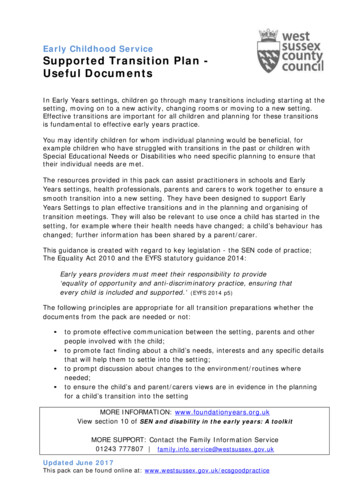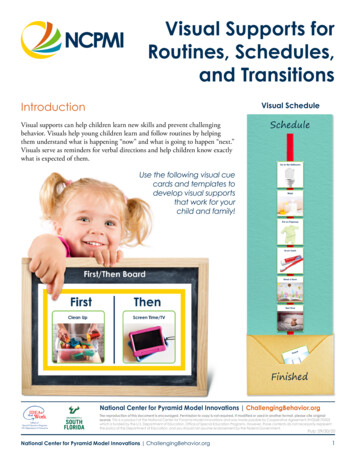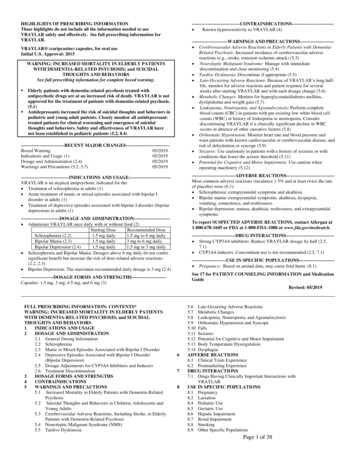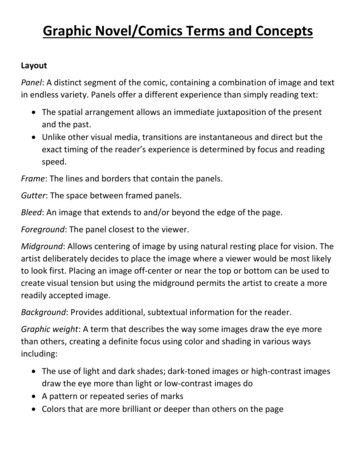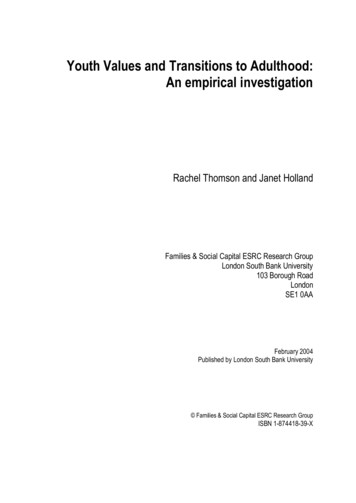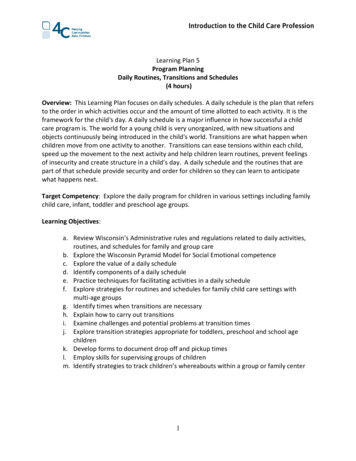
Transcription
Introduction to the Child Care ProfessionLearning Plan 5Program PlanningDaily Routines, Transitions and Schedules(4 hours)Overview: This Learning Plan focuses on daily schedules. A daily schedule is the plan that refersto the order in which activities occur and the amount of time allotted to each activity. It is theframework for the child's day. A daily schedule is a major influence in how successful a childcare program is. The world for a young child is very unorganized, with new situations andobjects continuously being introduced in the child's world. Transitions are what happen whenchildren move from one activity to another. Transitions can ease tensions within each child,speed up the movement to the next activity and help children learn routines, prevent feelingsof insecurity and create structure in a child’s day. A daily schedule and the routines that arepart of that schedule provide security and order for children so they can learn to anticipatewhat happens next.Target Competency: Explore the daily program for children in various settings including familychild care, infant, toddler and preschool age groups.Learning Objectives:a. Review Wisconsin’s Administrative rules and regulations related to daily activities,routines, and schedules for family and group careb. Explore the Wisconsin Pyramid Model for Social Emotional competencec. Explore the value of a daily scheduled. Identify components of a daily schedulee. Practice techniques for facilitating activities in a daily schedulef. Explore strategies for routines and schedules for family child care settings withmulti-age groupsg. Identify times when transitions are necessaryh. Explain how to carry out transitionsi. Examine challenges and potential problems at transition timesj. Explore transition strategies appropriate for toddlers, preschool and school agechildrenk. Develop forms to document drop off and pickup timesl. Employ skills for supervising groups of childrenm. Identify strategies to track children’s whereabouts within a group or family center1
Introduction to the Child Care ProfessionResources:Internet links: Challenging Behavior Pyramid Model Overview Video Wisconsin Administrative Licensing Rules and Regulations for Family Child CareWisconsin Administrative Licensing Rules and Regulations for Group Child Care Pyramid Model Backpack connection series, transitionsHandouts: Movin’ On: Supporting Transitions for Infants and Toddlers How to Help Your Child Transition Smoothly Between Places and Activities Classroom Management Made Easy: School-Age Transition Tricks for Teachers!IntroductionAs a child care professional you have the opportunity to impact the children and families youserve in a positive way. Along with the children and families, you also impact the futureworkforce, the schools and your community. To effectively nurture children’s emotional, social,physical and cognitive health and development, a child care program must pay close attentionto program planning; daily routines, transitions, and schedules.Assignment 1Review Wisconsin’s rules and regulations related to daily activities.Assignment 2Overview of Pyramid Model for Social and Emotional Competence Instructions: Watch the following video and record your thoughts:https://youtu.be/xYYOUtMHHJs2
Introduction to the Child Care ProfessionValue and components of daily schedule:Daily schedules are made up of routines, schedules and transitions. The terms routines andschedules are often used interchangeably, when they are actually different. Schedulesrepresent the big picture of what happens throughout the day. Routines are the steps thatoccur to complete each part of the schedule. An example of a schedule might be the blocks oftime that particular activities occur throughout the day, such as:9:00 Breakfast9:30 Outside10:30 Free choice11:30 Large Group11:45 LunchA routine involves a series of steps, often the same, to complete a part of the schedule.Consider circle time: a child chooses a place at the rug, sits on her bottom, sings a song, andthen listens to a story. This is the routine of circle time.Because schedules and routines are repetitive they help children learn the classroom activities.They can begin to predict what will happen next which allows them to feel prepared andsecure. Consistent schedules and routines allow children to understand the expectations of thelearning environment and the teachers.There are several components to a daily schedule.Balance Quiet vs loud activities Techer directed vs child lead Indoor vs Outdoor playChoice How many activities are available to each child? Is there variety in the activities to ensure all children’s interest are represented? Is the attention span of children considered in planning for choices?Culture and background of children and families Do materials and activities reflect the children in your group and what they mayexperience daily?Length of Play How long do children have to become actively involved in play? The Environment Rating Scales guide us in understanding that children needabout 1/3 of the day dedicated to free play. YoungStar’s developmentallyappropriate practices criteria states that children should have at minimum 50minutes of uninterrupted free play.3
Introduction to the Child Care ProfessionAssignment 3Review sample daily schedulesListed here, is an example of a daily schedule. In addition to this schedule, find samples of dailyschedules for toddlers, preschoolers, school age and multi-age or family child care programsand record them below. Attach additional paper if needed.6:30 Arrival and Free Play Time9:00 Breakfast9:30 Story Time9:45 Outside Time10:45 Free Play11:45 Large GroupToddler12:00 Lunch12:30 Quiet Time1:00 Rest Time3:00 Snack3:15 Free Play5:00 Good Bye’sPreschoolSchool Age4Multi-Age/FamilyChild Care
Introduction to the Child Care ProfessionAssignment 4Share examples of your own personal routines, schedules and transitionsInstructions: Write down a personal daily schedule that you follow. Include any transitions androutines that may be included. Attach additional paper if needed. See the example here:5:00 – wake up7:00 - wake kids up5:15 – workout7:15 – pack lunches6:15 – breakfast7:30 – drive to school and work6:30 – shower and get dressed8:00 – arrive at workTime of day:Activity and why it is important:Assignment 5Being RushedShare an example of a time when you have felt rushed and were not ready to take part insomething because others did not wait for you. Describe how you handled the situation and thefeelings that you had. Is there anything that another person could have done to make thesituation better?5
Introduction to the Child Care ProfessionAs you reflect on what it feels like to be rushed and/or to have your schedule disrupted,consider how a child in your care may feel in a similar situation. When children’s schedules androutines are interrupted behaviors may become challenging. Just like adults, it is difficult tohave to quickly adapt. Many children are unable to explain why or what it is that is makingthem upset in these situations making it important for caregivers to use empathy and recognizethe importance of schedules and routines.Visual cues are important and helpful for learning parts of routines as well as the dailyschedule. Just as an adult might find it important and even necessary to know what comes nextin his/her day to be successful, so do children. A posted visual schedule allows children to seeand learn the schedule of their day. Follow the link below to find examples of visual dailyschedules. www.pinterest.com Search visual scheduleThe following may be helpful in completing the next two assignments. Consider showingsamples of free visual cues from Pinterest or you can even create your own visual dailyschedule or use your own photos or images.Assignment 66
Introduction to the Child Care ProfessionCreate a visual daily schedule that you will follow in your learning environment and practicefacilitating the different activities throughout the day.Instructions: Organize typical activities (such as group time, individual play time, outside time,meals and snacks, rest time ) into a daily schedule for a selected age group. Make a note nextto each activity about how it felt to facilitate the activity. (If you are not currently working withchildren, make a daily schedule and note how you expect to facilitate the activity.)7
Introduction to the Child Care ProfessionTransitions:Just as adults generally prefer to be prepared and aware of changes, children are no differentwith their need to be prepared for changes to happen throughout their day or schedule. This iswhy planning for transitions is so important.As mentioned earlier, transitions are what happen when children move from one activity toanother. There are many times throughout the day when transitions are necessary. Transitionsoccur between activities at the program, such as between snack and outside time or betweenfree play and circle time. Transitions occur between settings on the same day, such as a childcoming from home to child care, or from 4k to wrap around care. Thoughtfully plannedtransitions decrease the potential for challenging behavior to happen, create opportunity forgrowth and development and increase child engagement.Many teachers express frustration and stress about children’s behavior during transitionaltimes of the day. Often this is a result of children spending long periods of time waiting, or notknowing or understanding the expectation of the teacher or environment. The EnvironmentalRating Scales, by Thelma Harms states that waiting with nothing to do for more than threeminutes is considered a long time to wait, or too long.A common misconception in the early care and education field is that children come to usknowing how to move through the day and what is expected of them. In fact, children need tobe taught the expectation of each part of their day. For some children, this will come veryeasily, and for others an educator will need to be spend more time and use a variety ofstrategies to teach these skills. This is similar to other academic skills we teach children. Somechildren learn new math concepts quickly and others require more time and alternate teachingstrategies from the adult to be successful.With this in mind, recognize that you must teach a child what s/he “should be doing,” during atransition. An example can be illustrated during clean up time. Some preschool-aged childrenwill understand the clean up time expectations right away. For other children it will benecessary for you to describe in words and pictures the steps of cleanup time. Here is oneexample of how to do that:1) Provide advanced warning that clean up time will be happening, with words and visualcues. You can flash the lights as a visual cue and say quietly to each group of children,“In five minutes we will have clean up time.”2) After five minutes are up, turn the lights off and state that it’s clean up time. Someteachers like to play or sing a clean up song during this time.3) If a child is unsure what to do, explain to them, step by step, which materials to putaway and where they go. “Johnny, let’s pick up the rectangle blocks here and put themon the shelf, next to the label,” as you role model for Johnny how to do this.4) Provide information about what children should do when they are finished with thetransition and waiting for others. For example, you can tell them, “When you arefinished cleaning up, find a book to look at in the quiet area.”8
Introduction to the Child Care ProfessionIn addition to teaching the steps of transitions, children and teachers are more successful whenthey plan a schedule with as few transitions as possible. This can be done in many differentways, including allowing for more free play rather than having children rotate between stationson a set schedule or incorporating small group activities into free play. This allows us tomaximize the amount of time children are spending engaged in activities where growth anddevelopment is occurring. Review the classroom daily schedule, you created and identify wherechanges could take place to reduce transitions.Transition strategies to use: Design a schedule with minimal transitions each day Prepare children for a change or transition During transitions, ensure children are engaged in activity, rather than waiting Teach the expectations of the schedule and transition to the large group Individualize your teaching for those children who are having difficultyWhen children are intentionally taught the steps to the routine and the schedule, there is adecrease in challenging behavior. But keep in mind that new transitions take time to teach andtime to learn. Be patient with children as you work together to discover what kinds oftransitions work best for everyone.9
Introduction to the Child Care ProfessionAssignment 7Explore transition strategies for each age group by reading the following articles in handouts:“Movin’ On: Supporting Transitions for Infants and Toddlers”“How to Help Your Child Transition Smoothly Between Places and Activities”“Classroom Management Made Easy: School-Age Transition Tricks for Teachers!”10
Introduction to the Child Care ProfessionAssignment 8Transition Strategies, What’s Appropriate and When?Next to each part of the day, list an appropriate transition strategy to use.Times a transitionstrategy should beused.Example:Inside to outsidetimeStrategy to useMovement: stomp like elephants to our playgroundNapCircle time/LargegroupClean upMeal timesToileting11
Introduction to the Child Care ProfessionAttendance forms and supervisionFor the health and safety of children, at all times it is necessary to know the number of childrenyou are supervising. A child care provider must be able to state at all times, how many childrenare in their care. Caring for Our Children, the National Health and Safety PerformanceStandards, Guidelines for Early Care and Early Education Programs, written by the Academy forPediatrics, reminds us that supervision is basic to safety and the prevention of injury andmaintaining quality child care. To be available for supervision an adult must be able to hear andsee the children.Early care and education providers should regularly count children, utilizing a name to facesystem on a scheduled basis and record the count on an attendance form or other card on/inhis/her possession. This should include any notes regarding children joining or leaving thegroup. This includes at every transition, and whenever leaving one area and moving to another,such as indoors to outdoors. The counting/tracking responsibility should be assigned to a staffperson to ensure it is done regularly.The importance of supervision is not only to keep children physically safe, but also to preventharm that can be caused from other inappropriate behaviors or conversations. It is theresponsibility of the care giver to know what children are talking about and intervene whenneeded.“Adults who are involved, aware and appreciative of young children’s behaviors are in the bestposition to safeguard their well-being” (Caring for Our Children). Active and positivesupervision involves: Knowing each child’s abilities;Establishing clear and simple safety rules;Being aware of and scanning for potential safety hazards;Placing yourself in a strategic position so you are able to adapt to the needs of the child;Scanning play activities and circulating around the area;Focusing on the positive rather than the negative to teach a child what is safe for thechild and other children;Teaching children the developmentally appropriate and safe use of each piece ofequipment.The use of attendance forms for drop off and pick up times is required and necessary to trackthe children in your care. Review the tracking system utilized in your program. The systemused should allow you to answer the following questions:1) Do you know what children are in your care at all times? Is this documented at alltimes in a place where you have access to it?12
Introduction to the Child Care Profession2) When a child leaves the group, but is still in care at the program, how is itdocumented for both the caregiver the child is with and the caregiver who is withthe larger group?3) Are all children signed in and out by their parent/guardian or authorized pick up ordrop off person?Research and/or develop a drop off and pick up form to meet the necessary tracking systemrequirements, which will help to ensure all children are safe and in supervision of an adult.Review the DCF attendance form as an example.13
Daily Routines, Transitions and Schedules (4 hours) Overview: This Learning Plan focuses on daily schedules. A daily schedule is the plan that refers to the order in which activities occur and the amount of time allotted to each activity. It is the framework for the child's day. A daily schedule is a major influence in how successful a child





